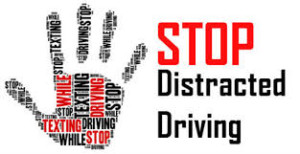
In recognition of Distracted Driving Awareness Month, AAA reminds motorists that according to the National Highway Traffic Safety Administration, an estimated 3,477 people were killed nationwide in motor vehicle crashes involving distracted drivers in 2015.
For the first time in nearly a decade, preliminary 2016 data estimates more than 40,000 people died in motor vehicle crashes last year in the U.S. and about 10 percent of those were due to distracted drivers. The 2016 U.S. death toll marks a six percent increase over 2015, and a 14 percent increase over 2014, the most dramatic two-year escalation since 1964, according to the National Safety Council.
The South Dakota Dept. of Public Safety says there was a total of 17,791 traffic crashes across the state in 2015, compared with 17,346 in 2014. The number of crashes involving a distracted driver rose from 1,032 in 2014 to 1,125 in 2015, the last year for which statistics are available. Bear in mind that driver distraction in these crashes is largely self-reported and is undoubtedly low.
Distracted driving is any activity, such as grooming, eating, or the most common diversion – texting – that takes a driver’s attention off the road. AAA reminds motorists that not only is texting while driving unwise, it’s also against the law in South Dakota.
AAA South Dakota urges drivers to put the cellphones down not only in April, but all year. AAA’s annual Traffic Safety Culture Index (TSCI) released earlier this year, finds that young millennials are the riskiest drivers, with two in three drivers admitting to talking on a cell phone while driving.
According to the AAA survey:
Drivers ages 19-24 were 1.6 times as likely as all drivers to report having read a text message or e-mail while driving (66.1 percent vs. 40.2 percent).
Drivers ages 19-24 were nearly twice as likely as all drivers to report having typed or sent a text message or e-mail while driving (59.3 percent vs. 31.4 percent).
For several years running now, the TSCI has revealed a culture among US drivers of “Do as I say, not as I do.” The same drivers who describe texting and other risky behavior as unacceptable, also admit to engaging in it.
“Alarmingly, some of the drivers ages 19-24 believe the risks they take behind the wheel aren’t a big deal,” said Marilyn Buskohl, spokeswoman for AAA South Dakota. “It’s critical that these drivers understand the potentially deadly consequences of engaging in these types of behaviors and that they change their attitudes in order to reverse the growing number of fatalities on our roads.”
Texting and driving requires motorists to take their eyes off the road, hands off the wheel, and mind off the task of driving. This is a recipe for a crash. AAA says your life and the lives of others you share the road with, depend on and deserve your full attention. Put the phone down.
AAA research has found that the cognitive distraction of a conversation and using technology is more dangerous than first thought, and may distract drivers up to 27 seconds after they hang up the phone.
Tips for Safe Driving
As a general rule, if you cannot devote your full attention to driving because of some other activity, it’s a distraction. Take care of it before or after your trip, not while you’re behind the wheel.
Stow loose gear, possessions or other distractions that could roll around in the car so you don’t feel tempted to reach for them on the floor or the seat.
Put aside your electronic devices. Do not use cellphones while driving – whether handheld or hands-free – except in absolute emergencies.
Make vehicle adjustments before you begin your trip – address vehicle systems like GPS, seats, mirrors, climate controls and sound systems – before hitting the road.
Passengers can do a lot to help reduce the risk of distracted driving, too. If you’re riding shotgun, be a good passenger and help minimize distractions for the driver. If you see the driver is becoming distracted, speak up and offer assistance.
AAA’s Top Five Tips for Passengers
Buckle up: Be sure to immediately buckle up once you get into the vehicle. This will avoid an unnecessary conversation later with the driver. The driver needs to concentrate on the task at hand – driving.
Be a good co-pilot: Essentially, help drive the car. Support the driver by being an extra set of eyes, ears and hands. Ensure other passengers act responsibly. Remind the driver to put it down, don’t text and drive. Should an opportunity arise, offer to help.
Stay awake: Although it can be tempting to doze off, keep the driver company and offer assistance when necessary. If your GPS isn’t working properly or the driver gets lost, your fully charged smartphone will help to safely navigate you to your destination.
Don’t be a back-seat driver: Abstain from being negative and pointing out every little mistake. This adds to the driver’s stress level instead of easing it. Steer clear of agitating the driver. Remember, a calm driver is a safe driver.
Control your emotion: If you think there is emerging danger, control your impulses and reactions. Calmly let the driver know, but do not shout, grab the steering wheel or hand brake as this will only make things worse.
